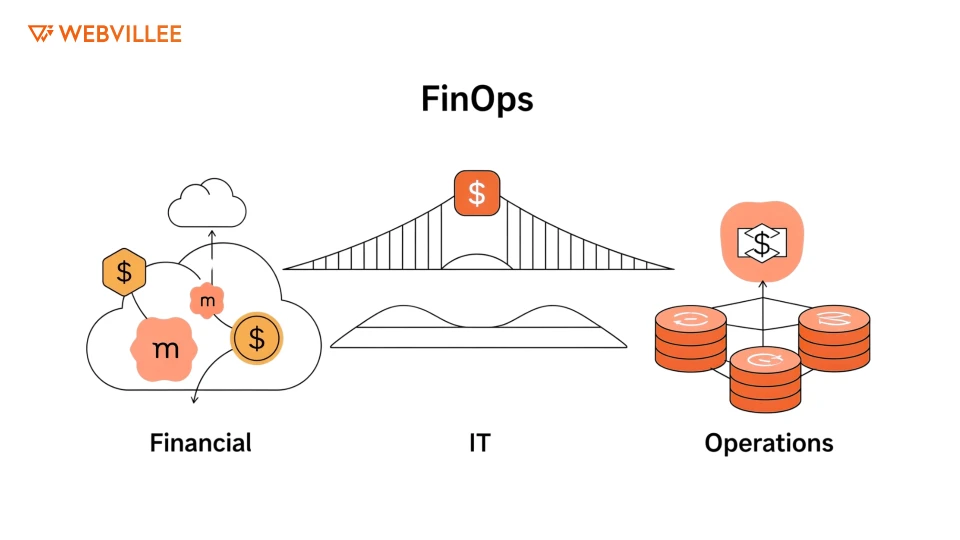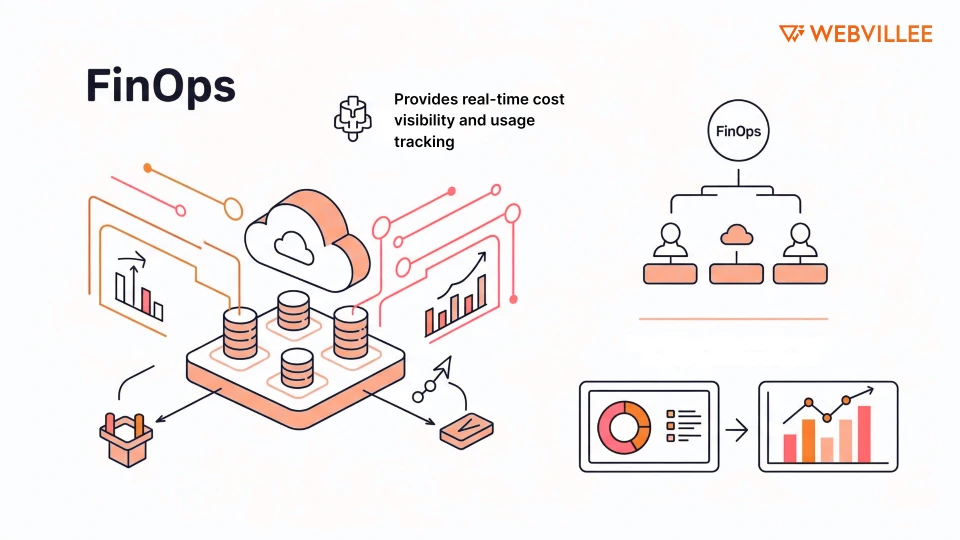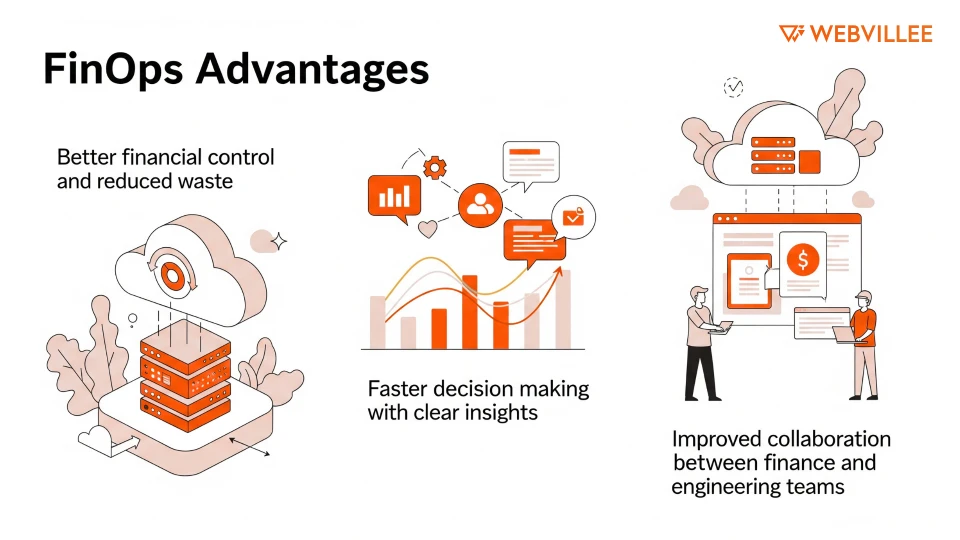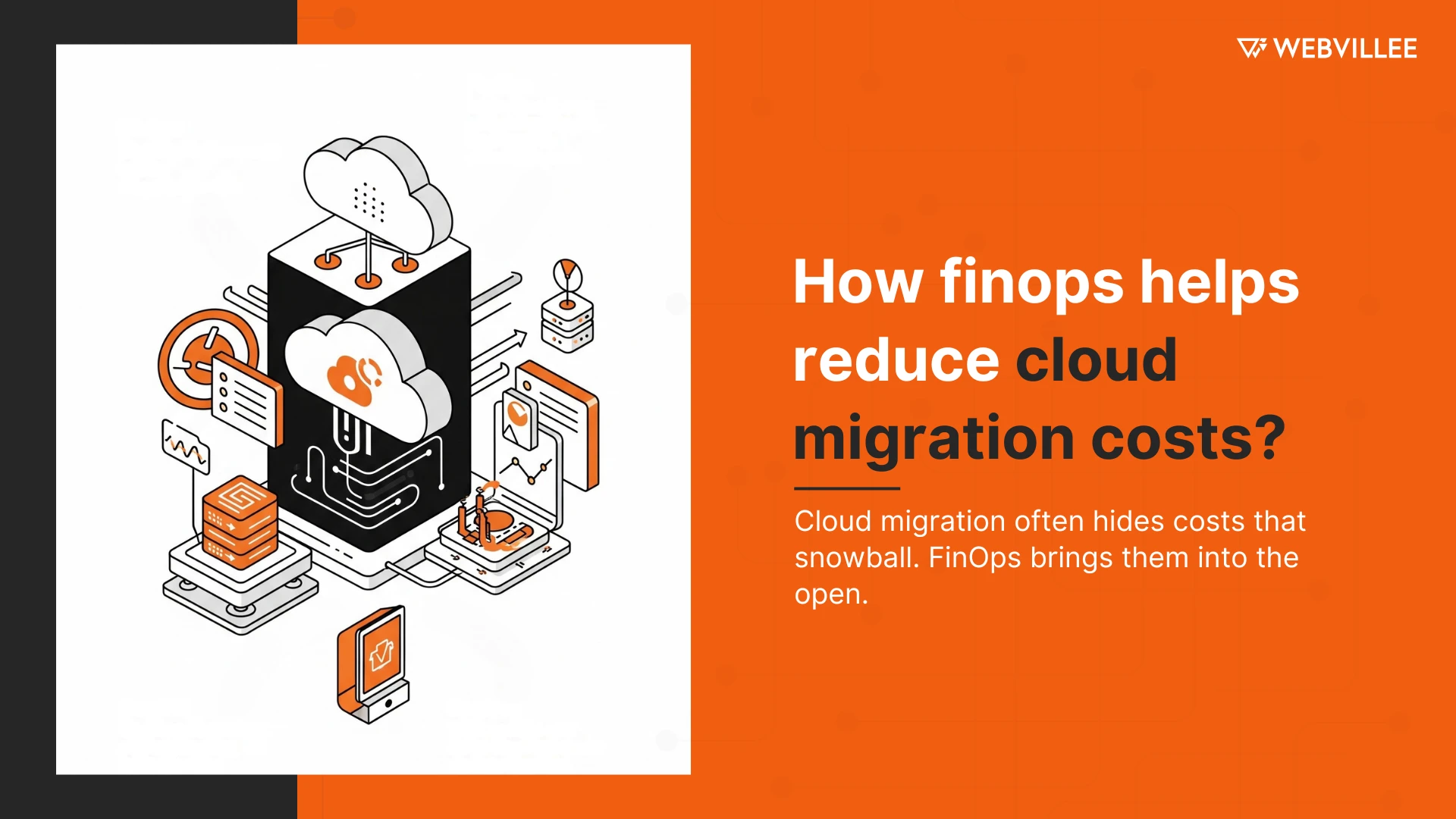Enterprises adopt cloud migration to gain scalability, flexibility, and efficiency. However, many projects face unexpected expenses that go beyond the initial budget. To stay in control and reduce cloud migration costs, businesses need a structured approach to managing cloud spending.
FinOps, short for Cloud Financial Operations, offers that framework. It brings finance, technology, and operations teams together to monitor and optimize cloud expenses. By aligning usage with business goals, FinOps helps organizations gain visibility into costs and take corrective actions before spending spirals out of control.
In this blog, we will cover:
- What FinOps is and why it matters in 2025
- Why hidden cloud costs occur during migrations
- How FinOps practices improve cost efficiency
- Ways to apply these practices for better financial control
By the end, you will see how adopting FinOps principles can turn cloud migration into a cost-effective and transparent process.
What Is FinOps?
FinOps, short for Cloud Financial Operations, is a discipline that helps organizations take control of their cloud spending. Instead of treating cloud expenses as unpredictable costs, FinOps turns them into measurable and manageable investments.
In simple terms, FinOps creates a framework where finance, IT, and operations teams work together. This collaboration ensures that every dollar spent on cloud resources is tracked, optimized, and tied to business outcomes.
Key principles of FinOps include:
- Visibility: Real-time insights into where cloud costs are coming from
- Accountability: Teams share responsibility for managing and optimizing their usage
- Optimization: Continuous efforts to remove waste and improve cost efficiency
These principles allow businesses to make data-driven decisions rather than relying on guesswork. With cloud adoption growing rapidly, uncontrolled spending can quickly drain budgets. FinOps addresses this by enforcing transparency and encouraging smarter usage.
The adoption of FinOps practices is increasing in 2025 because enterprises now operate in complex multi-cloud and hybrid environments. These setups offer flexibility but also make cost tracking more challenging. FinOps bridges that gap, ensuring cloud investments deliver the expected value without overspending.

Why Cloud Migration Costs Often Exceed Budgets
Many businesses start cloud migration with a clear budget, only to find expenses growing beyond expectations. The reason is simple: several hidden costs often go unnoticed until they accumulate.
Common sources of unexpected expenses include:
Idle resources: Instances running without being used still generate charges.
- Over-provisioning: Allocating more computing power or storage than required.
- Data transfer fees: Costs incurred when moving large volumes of data between regions or services.
- Untracked usage: Multiple teams spinning up resources without oversight.
The lack of real-time cost visibility and poor resource tracking make these problems worse. Without monitoring tools or structured practices, businesses fail to identify inefficiencies early, leading to higher bills.
For enterprises handling large-scale migrations, these uncontrolled costs can impact budgets significantly. Teams often focus on technical execution while overlooking cost management, resulting in wasted resources.
Adopting strategies that reduce cloud migration costs is essential. This is where cloud cost optimization comes into play, ensuring resources are sized and used efficiently. Pairing this with professional cloud cost management services helps organizations monitor spending, control usage, and maintain accountability throughout the migration.
How FinOps Helps Reduce Cloud Migration Costs
FinOps is not just about tracking expenses; it is about making cloud spending smarter. By applying its principles, enterprises can effectively reduce cloud migration costs while still achieving performance and scalability goals.
One of the core strengths of FinOps is its ability to provide real-time cost visibility. Teams can see exactly how resources are being used and which services are driving costs. This transparency makes it easier to identify waste, stop unused resources, and optimize workloads during migration.
How FinOps makes a difference:
- Real-time tracking: Allows quick detection of unnecessary expenses.
- Shared accountability: Finance, IT, and operations teams work together to manage cloud budgets.
- Data-driven decisions: Spending data guides resource allocation and future planning.
- Continuous optimization: Costs are reviewed regularly, not just at the end of the project.
FinOps also promotes the culture of accountability, where every team that uses cloud resources is responsible for its spending. This prevents uncontrolled growth in costs and ensures alignment with business objectives.
By encouraging collaboration, monitoring usage closely, and making optimization an ongoing process, FinOps transforms cloud migration from a cost-heavy exercise into a financially efficient strategy. For enterprises, this means gaining better control, avoiding budget overruns, and realizing the true value of their cloud investments.

Key FinOps Practices to Apply During Migration
Applying FinOps principles during migration ensures costs remain predictable and controlled. These practices help organizations optimize spending while maintaining performance.
1. Budget Forecasting and Cost Allocation
Start by setting clear budgets for each phase of migration. Allocate costs to specific teams or projects so everyone understands their financial responsibility. This visibility reduces surprises and encourages more careful use of resources.
2. Right-Sizing Cloud Resources
Over-provisioning is a common source of wasted spending. Right-sizing means matching cloud resources to actual demand, scaling them up or down as needed. This prevents paying for capacity that is not being used.
3. Automating Cost Monitoring and Alerts
Manual tracking is inefficient. Use automation to monitor spending in real time and trigger alerts when usage exceeds thresholds. This proactive approach helps address issues before they impact the budget.
4. Continuous Optimization Post-Migration
Cost management does not end once migration is complete. Ongoing reviews and optimizations ensure resources remain efficient as workloads evolve. This includes turning off idle services and refining configurations over time.
For organizations without in-house expertise, engaging with cloud migration consulting can make implementation smoother. Consultants bring experience with FinOps tools and frameworks, helping businesses set up automated monitoring, right-sizing policies, and effective cost allocation from the start.
Benefits of Using FinOps in Cloud Projects
FinOps provides a structured approach to managing cloud spending, offering clear benefits for businesses undergoing migration. By applying FinOps principles, enterprises gain control over expenses and improve the return on their cloud investments.
1. Better Financial Control and Reduced Waste
FinOps creates visibility into where money is being spent and where resources are underutilized. This makes it easier to cut unnecessary costs, optimize usage, and reduce cloud migration costs significantly.
2. Faster Decision-Making with Clear Insights
With real-time data on spending and usage, teams no longer rely on delayed reports. FinOps offers actionable insights that guide quick decisions on scaling resources, adjusting budgets, or stopping wasteful services.
3. Improved Collaboration Between Teams
Traditionally, finance and engineering operate separately. FinOps bridges this gap by aligning both teams under shared goals. Engineers understand the financial impact of their choices, and finance teams gain visibility into technical decisions.
4. Continuous Optimization Beyond Migration
The benefits of FinOps do not end when the migration is complete. It encourages ongoing monitoring and optimization, ensuring costs remain under control as the cloud environment evolves.
By enabling financial accountability, streamlining decision-making, and fostering teamwork, FinOps helps organizations maintain control and efficiency in every stage of their cloud projects. It turns cloud adoption into a cost-effective strategy rather than a budget challenge.

How Webvillee Implements FinOps Principles for Clients
At Webvillee, we help businesses control cloud costs while ensuring smooth migrations. Our approach integrates FinOps principles into every stage of cloud adoption, focusing on both technical execution and financial efficiency.
We assist clients by:
- Building cost-aware migration strategies that prevent overspending
- Implementing monitoring tools for real-time visibility into cloud usage
- Applying optimization techniques to eliminate waste and improve performance
- Establishing cost governance so teams stay accountable for resource usage
Our experience with hybrid and multi-cloud environments allows us to manage complex workloads without hidden expenses. We ensure that businesses not only migrate successfully but also maintain cost control long after the move.
If you want to optimize your cloud spending while ensuring a seamless migration, feel free to Get in Touch. Our team is ready to help you achieve a cost-efficient and well-managed cloud environment.

